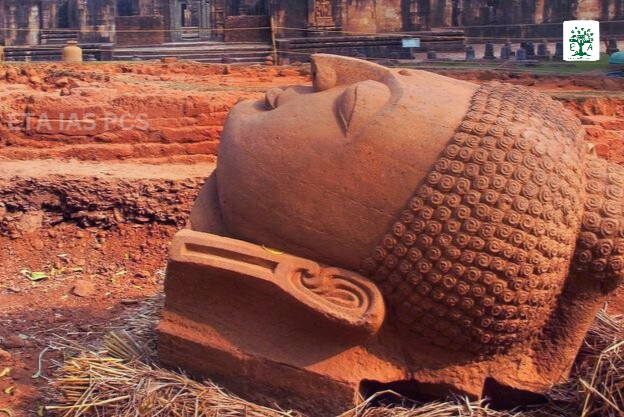A team of archaeologists convened at a mound located in the southern section of the 18-acre Ratnagiri Buddhist heritage site in the Jajpur district of Odisha to excavate artifacts buried beneath the ground. The most notable find is a Buddha head measuring 1.4 meters in height.
The Significance of the Subject: Preliminary Information Regarding the Ratnagiri Buddhist Site and Vajrayana Buddhism.
About the site

Meaning of Ratnagiri: The name “Ratnagiri” translates to ‘hills of jewels’ in Odia.
Location: Ratnagiri is situated on a hillock within the Assia hill range in Jajpur, Odisha.
Rivers and Tributaries: The village is bordered by the Brahmani, Kimiria, and Birupa rivers, along with their tributaries.
Distance from Bhubaneswar: Ratnagiri is approximately 100 kilometers away from Bhubaneswar.
Part of the ‘Diamond Triangle’: Ratnagiri is included in the ‘Diamond Triangle,’ a region that includes three significant Buddhist sites: Ratnagiri, Udayagiri, and Lalitgiri, all within a 10-kilometer radius.
Archaeological Evidence: Sculptural and epigraphic remains suggest that the earliest Buddhist community in Ratnagiri emerged in the 5th century AD.
Period of Prosperity: Ratnagiri experienced considerable prosperity as a Buddhist center until the 13th century.
FINDINGS
Copper Plate Charter: A copper plate charter from Somavamsi King Karna confirms that the location was a center for Vajrayana (Tantric Buddhism).
Sculptural Findings: Three sculpted heads of various dimensions have been discovered.
Monolithic Elephant Sculpture: A monolithic sculpture of an elephant was found.
Votive Stupas: Numerous votive stupas, ranging from simplistic to elaborately adorned, have been uncovered.
Masonry Structures: Brick and stone masonry structures were also revealed during excavation.
Stone Tablets: Stone tablets of assorted sizes, inscribed in Sanskrit using the Kutila script (Siddhamatrika), were found.
Ceramic Collection: The ceramic collection is mainly characterized by fine grey ware in diverse shapes and sizes.
Lion Pedestal and Votive Sculptures: A lion pedestal (Buddha’s Simhasana) and votive sculptures of Buddhist deities were discovered, including:
- Amoghasiddhi: One of the five wisdom Buddhas in the Mahayana and Vajrayana traditions.
- Ratnasambhava: One of the five meditating Buddhas.
- Akshobhya: Another wisdom Buddha.
- Amitabha: One of the most revered figures in Mahayana Buddhism.
Vajrayana Buddhism Overview: Vajrayana Buddhism, also known as Tantric Buddhism or Mantrayana Buddhism, is a distinct tradition that focuses on esoteric practices and rituals aimed at achieving rapid spiritual awakening.
Emergence: Vajrayana Buddhism emerged during the 5th century AD, coinciding with the reign of the Gupta dynasty in Northern India.
Regions of Practice: It is predominantly practiced in regions such as Ladakh, Tibet, China, Nepal, Bhutan, and Japan.
Key Symbol – Vajra: The vajra, a ritual tool symbolizing indestructibility and an irresistible force, represents the harmonious union of wisdom and compassion.
Ultimate Aim of Practice: The goal of both Mahayana and Vajrayana traditions is to attain the status of Sammāsambuddha (fully awakened Buddha), with practitioners referred to as Bodhisattvas on their journey.
Techniques Used: Practices include the use of:
- Mantras: Sacred sounds.
- Dhāraṇīs: Mnemonic codes.
- Mudrās: Symbolic hand gestures.
- Mandalas: Spiritual diagrams.
- Visualization of Deities and Buddhas: To aid the pursuit of enlightenment.
Transmission of Teachings: The teachings are transmitted from teacher to student through initiation ceremonies.
Significant Centers: Nalanda Mahavihara is recognized as a significant center for Vajrayana teachings.
Deity Yoga: This practice involves visualizing oneself as a deity embodying enlightened attributes.
Feminine Energy in Vajrayana: The tradition acknowledges the importance of feminine energy, honoring female Buddhas and ḍākiṇīs (spiritual beings), a perspective less emphasized in Hinyana and Mahayana traditions.
Influence on Other Traditions: Tibetan Buddhism, Japanese Shingon Buddhism, and Chinese Buddhism have all been significantly influenced by Vajrayana Buddhism.
